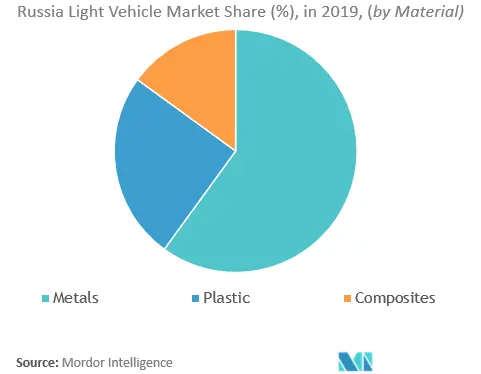Market Trends of Russia Light Vehicle Industry
This section covers the major market trends shaping the Russia Light Vehicle Market according to our research experts:
Continuous Evolution in automotive AHSS technology
There is a demand for reducing the weight to enhance vehicle performance and safety. As a result, Advanced High Strength Steel (AHSS), an essential material for mass vehicle reduction, and has become one of the fastest-growing material in today's automotive industry.
Steel makes up around 70 % of an average automobile's weight. Compared to standard steel, AHSS enable to reduce vehicle weight by 23-35% which is around 165 to 250 kg, for a regular passenger car, saving 3 - 4.5 tons of greenhouse gases over the vehicle's total life cycle. This saving in emissions is much more substantial than the CO2 emitted during the complete production of steel needed in a car.
The steel composition involves 34% as the body structure, panels, doors, and trunk closures, giving it an energy absorption and high-strength in case of a crash. 23% is the engine and machinable carbon steel for the wear-resistant gears. 12% is used in the suspension, using rolled high-strength steel and the remainder in the wheels, tires, fuel tank, steering, and braking systems.
To produce higher strength for reduced steel section size and weight, automakers use less material, significantly reducing a vehicle's weight. The steel industry is focusing on developing different alloys for processing combinations, steel with high tensile strength and ductility, along with optimizes chemical compositions to achieve multiphase microstructures of AHSS.
Other advancements include the expanded capabilities to automotive steels that have high strength, which enable the design of thinner parts optimizing stiffness but maintaining geometries. AHSS such as Nano Steel helps deliver thinner gauges of steel and components to manufacture at room temperature.
In 2018, the technical partnership between Aston Martin and Dow has enabled the development towards AHSS and implementation of customized industry-leading solutions in light-weighting, powertrain efficiency, and vehicle electrification.

There is a Growing Demand for lightweight cars in Russia
Many Russian companies are experimenting with new composites that can reduce the vehicle's total weight to a great extent. The application of carbon-fiber-reinforced plastic (CFRP) has been widely adopted to produce automotive bodies. However, even in Russia, the high cost of materials like carbon fibre and AHSS, and the ongoing research on the material mix, the growth of this industry hasn't reached its full potential.
Russia is one of the largest manufacturers of lightweight vehicles. With the market for lightweight vehicles in development, various initiatives within Russia are driving the technological advancements. As per, government regulatory framework, there is a growing motivation for a low-carbon economy by 2050.
Russian carmakers such as LADA, Kia, Renault and Hyundai are working together to produce more efficient vehicles. Their goal is to reduce energy consumption by 10% and global warming potential (GWP) by 6% by reducing the vehicle's weight by 31 to 33% while maintaining the cost.
Manufacturers are working to reduce overall vehicle weight, which lowers the energy required to operate the vehicle and increasing fuel economy. The Body-In-White system is the critical focal point for automakers looking for fuel savings because of its weight reduction potential, importance to crash safety, and impact on compounded weight reduction for other sub-systems, such as the powertrain.


